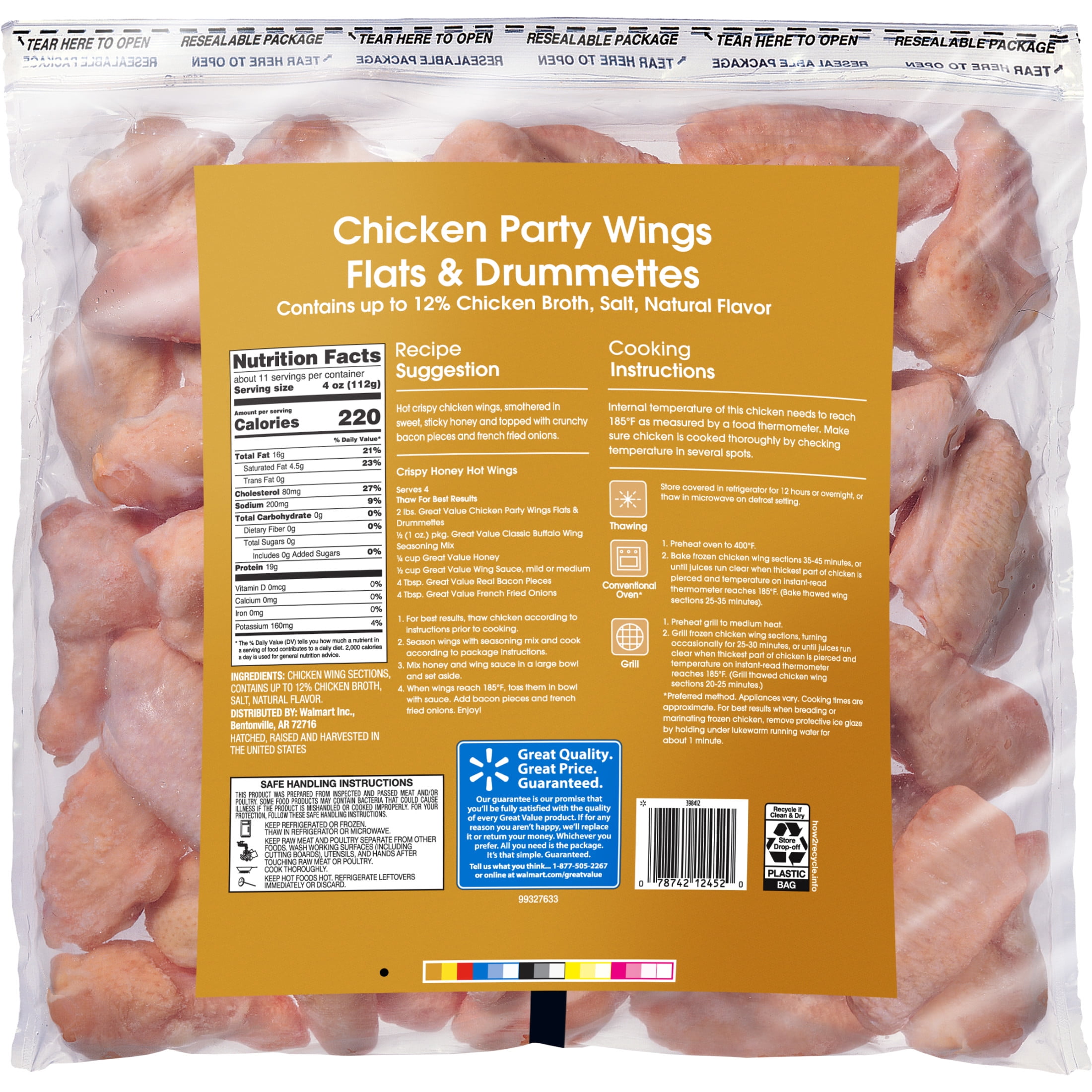
Chicken wings are a popular snack loved by many. They can be savory, spicy, or sweet.
Let’s dive into the world of chicken wing nutrition facts. This tasty treat comes packed with proteins and other nutrients, but it’s also true that they can carry a significant amount of fat and calories, especially when fried and drenched in sauce.
Understanding the nutritional profile of chicken wings is vital for those who love to indulge while trying to maintain a balanced diet. Whether eaten during a big game or as a comfort food, knowing what’s inside these bite-sized delights can help you enjoy them responsibly. In this post, we’ll explore the nutritional value of chicken wings, looking at the benefits and the things to watch out for. So, get ready to learn how this appetizing dish fits into your eating habits.
The Nutritional Profile Of Chicken Wings
Let’s dive into the nutritional profile of chicken wings. Often featured at sports events and family gatherings, chicken wings are a popular choice. Understanding what these tasty morsels pack in terms of nutrition is key for mindful eating. They offer more than just flavor; they bring a host of nutrients to the table.
Caloric Content Breakdown
Chicken wings are calorie-dense. A single wing with skin has about 99 calories. Most come from proteins and fats. Watching portion sizes is important for calorie control.
Protein Power In Every Bite
These wings are rich in protein. One wing provides about 7 grams of protein. This helps in muscle repair and growth. For those building muscle or dieting, chicken wings can be a protein-packed snack.

Credit: cheatdaydesign.com
Vitamins And Minerals In Chicken Wings
Chicken wings are not just tasty. They’re also full of good stuff. This section talks about the vitamins and minerals in chicken wings. These nutrients are important for our health.
Essential Vitamins For Your Body
Chicken wings have vitamins your body needs. Vitamin B3, or niacin, helps your body use food for energy. Vitamin B6 in wings helps your brain work better. Wings also have Vitamin B12. This vitamin keeps your blood and nerve cells healthy. Don’t forget Vitamin D. It makes your bones strong. Vitamin A in wings is good for your eyes.
Minerals That Matter
Minerals in chicken wings are important too. They have zinc. Zinc helps your immune system fight off illness. Iron in wings carries oxygen in your blood. This keeps you feeling energetic. Phosphorus in chicken wings makes your bones and teeth strong. Wings also have selenium. Selenium protects your body from damage.
Healthy Fats Vs. Saturated Fats
When it comes to chicken wings, it’s not just about the taste. The nutrition within is key, especially the fats. People often hear about fats in a negative light. Yet, not all fats are the same. Healthy fats and saturated fats play different roles in our diets. It’s important to know which is which. Chicken wings have both, but understanding the balance can impact your health.
The Good Fats In Chicken Wings
Yes, chicken wings have good fats. These fats are called monounsaturated and polyunsaturated fats. They are good for your heart. They can help to keep cholesterol levels healthy. They also provide energy. Chicken wings have these fats, but in small amounts. Pair wings with a salad or veggies to get more good fats in your meal.
Understanding Saturated Fats
Chicken wings also have saturated fats. These fats can be less heart-healthy if eaten too much. They can raise bad cholesterol levels. This can lead to heart problems over time. It’s important to enjoy wings in moderation. Balancing them with foods that are low in saturated fat can help maintain a healthy diet.

Credit: www.walmart.com
Chicken Wings And Cholesterol
Chicken wings are a popular snack, but many worry about their cholesterol impact. Understanding their nutritional facts is key. Let’s explore how they affect heart health and cholesterol levels.
Impact On Heart Health
Chicken wings contain saturated fat and cholesterol, which can influence heart health. Eating wings in moderation is crucial to maintain a healthy heart.
- Cholesterol in wings can lead to plaque buildup in arteries.
- Excess consumption increases the risk of heart disease.
- Pair wings with heart-healthy sides like vegetables.
Balancing Cholesterol Levels
To balance cholesterol, consider both diet and lifestyle. Lean proteins and fiber-rich foods help manage levels.
| Food Choice | Impact |
|---|---|
| Baked wings | Lower in fat than fried |
| Vegetable sides | Add fiber to the meal |
- Choose baked over fried wings to reduce fat intake.
- Include fruits and veggies for a balanced meal.
- Regular exercise also helps control cholesterol.
Sodium Content In Chicken Wings
Chicken wings are a popular snack. They are tasty and easy to eat. Many people enjoy them during sports games or family gatherings. But, it’s important to know about their sodium content.
Sodium’s Role In Health
Sodium is a mineral. Our bodies need it to work well. It helps with muscle and nerve function. It also keeps the right balance of fluids in our body.
But, too much sodium is not good. It can lead to high blood pressure. This can harm your heart and kidneys.
Managing Sodium Intake
To stay healthy, we need to watch how much sodium we eat. The average adult should eat less than 2,300 mg of sodium per day. That’s about one teaspoon of table salt.
- Read labels to check sodium amounts.
- Choose low-sodium options when you can.
- Make chicken wings at home to control the salt.
Chicken wings from restaurants can have a lot of sodium. Making them at home lets you choose how much salt to add.
| Food Item | Sodium Content |
|---|---|
| Chicken Wings (4 pieces) | 800 mg |
| Homemade Chicken Wings (4 pieces) | <500 mg (with less salt) |
Eating chicken wings is fine. Just remember to watch the sodium. This way, you can enjoy them and stay healthy.
Comparing Cooking Methods
Let’s talk chicken wings. They’re tasty and popular. Yet, how you cook them matters for nutrition. We’ll look at baking versus frying. We’ll also share the healthiest ways to cook them.
Baked Vs. Fried Wings
Baked wings win for health. They have less fat than fried. This means fewer calories. Baking makes them crispy without extra oil. Fried wings taste great but soak up more fat. This ups the calorie count.
Healthiest Cooking Practices
For the healthiest wings, bake not fry. Use herbs and spices for flavor. Skip the breading. Serve with veggies. Enjoy your wings guilt-free!
Portion Control And Frequency
Understanding portion control and frequency is key to enjoying chicken wings without guilt. It’s about balance. Let’s dive into how you can enjoy these tasty treats and still keep your health in check.
Serving Sizes For Optimal Health
Chicken wings are delicious but knowing the right amount to eat is crucial. A good serving size is about 4-5 wings. This helps control calorie intake. Eating the right portion also means you get to enjoy other foods in your meal. Remember, balance is important.
- Keep portions small.
- Eat a variety of foods.
- Focus on balance.
How Often Should You Indulge?
Chicken wings are a treat, not a daily meal. Enjoying them once a week is a good rule. This keeps your diet varied and healthy. Always pair wings with vegetables or a salad. This adds nutrients and fiber.
- Limit wings to once a week.
- Pair with veggies or salad.
- Enjoy in moderation.
:max_bytes(150000):strip_icc()/chicken-leg_annotated-41227f1f9a6f45949a83c307fbd44c33.jpg)
Credit: www.verywellfit.com
Alternatives To Traditional Chicken Wings
Chicken wings are a favorite for many. Yet, some seek healthier choices. This section explores tasty alternatives to traditional chicken wings. These options are lower in calories and better for your health.
Plant-based Options
Looking for a veggie twist on wings? Plant-based options now mimic the classic flavors. These wings come from soy, seitan, or veggies. They pack a protein punch with fewer fats.
Leaner Meats For Health-conscious Eaters
Turkey and fish offer leaner protein choices. They’re high in nutrients and lower in fat than traditional wings. These alternatives are tasty and better for your waistline.
Frequently Asked Questions
How Many Calories Are In Chicken Wings?
A typical chicken wing has about 99 calories. This depends on how it’s cooked.
What Nutrients Do Chicken Wings Provide?
Chicken wings are rich in protein, vitamins B6 and B12, and minerals like zinc.
Are Chicken Wings High In Fat?
Yes, chicken wings contain fat, with around 8 grams per wing, including saturated fat.
Can Chicken Wings Be Part Of A Healthy Diet?
In moderation, chicken wings can fit into a balanced diet, especially if baked or grilled.
How Does The Cooking Method Affect Chicken Wing Nutrition?
Frying adds calories and fat. Baking or grilling is a healthier choice.
Conclusion
Understanding chicken wing nutrition is key to enjoying them healthily. These tasty snacks pack protein and various nutrients. Remember portion control and balance with veggies for a healthy meal. Chicken wings can be both delicious and part of a mindful diet.
So next time, savor the flavor while keeping nutrition in mind. Enjoy your wings the smart way!






